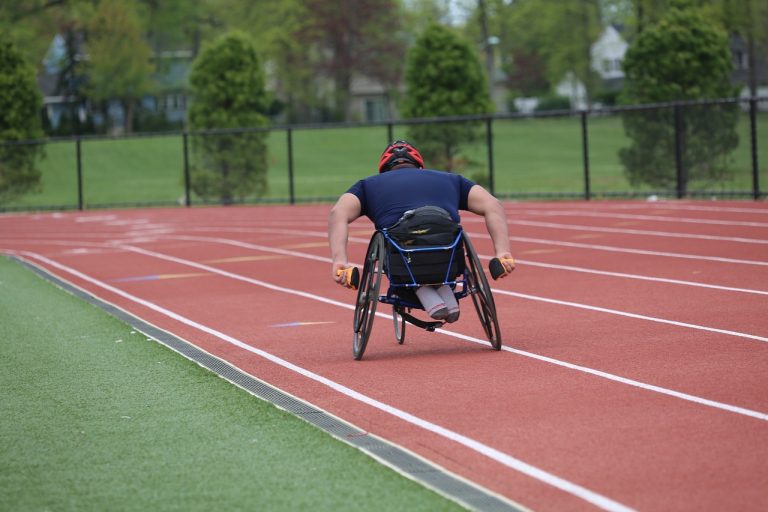General Rules of Hurdles (Track and Field)
When tackling obstacles in track and field, remember: Men's hurdles stand at 42 inches, while women's sit at 33 inches in height. Properly following height rules and safety guidelines is essential. Races have 10 hurdles for men and 8 for women, so spacing is key. Mastering the arm and leg coordination, maintaining a 90-degree elbow angle, and focusing on lead leg placement are vital. Make sure you nail the start line setup, hurdle protocol, and avoid lane violations. Learning about penalties and honing technique will pave your path to success on the track.
Hurdle Height Regulations
When setting up hurdles for a track and field competition, make sure to adhere to the specific height regulations stipulated by the governing body. Hurdle height adjustments are vital for the safety and fairness of the race. The standard height for men's hurdles is 42 inches (106.7 cm) and 33 inches (83.8 cm) for women. Proper equipment requirements must be met, ensuring that the hurdles are of the correct height and securely placed. Safety precautions, such as using proper technique and wearing appropriate gear, are essential to prevent injuries during training and competitions.
Training techniques play a key role in mastering the art of hurdling. Athletes must focus on improving their agility, speed, and coordination to navigate the hurdles successfully. Practicing proper form and rhythm will enhance performance and reduce the risk of tripping over the hurdles. By following the guidelines for hurdle height adjustments and adhering to safety protocols, athletes can maximize their potential and excel in track and field competitions.
Number of Hurdles in a Race
The standard number of hurdles in a track and field race is typically ten for the men's event and eight for the women's event. Understanding the layout of hurdles in a race is important for best performance. Here's what you need to know:
- Hurdle Spacing: The distance between each hurdle is standardized based on the race distance. Proper spacing guarantees athletes can maintain their momentum without having to drastically adjust their stride pattern.
- Race Distance: The number of hurdles correlates with the length of the race. Longer races may have more hurdles to challenge athletes' endurance and technique.
- Hurdle Adjustments: Athletes must make quick adjustments when approaching each hurdle. Proper technique and timing are essential to clear the hurdles efficiently.
- Race Preparation: Before the race, athletes need to mentally and physically prepare for the specific number of hurdles they will encounter. Visualizing the race and practicing hurdle drills are crucial components of race preparation.
Understanding the number of hurdles in a race and how they are spaced can have a significant impact on an athlete's performance and overall success on the track.
Proper Hurdling Technique
When hurdling, remember that arm movement is vital for balance and propulsion. Proper leg clearance technique is essential to avoid knocking over hurdles. Maintaining a consistent rhythm and timing between your jumps is key to a successful hurdling technique.
Arm Movement Importance
To enhance your hurdling performance, focusing on the precise coordination of your arm movements is crucial for maintaining balance and generating power. Proper arm swing and timing coordination are key components in executing efficient hurdling technique. Here are four essential points to contemplate:
- Opposite Arm and Leg Movement: Coordinate the movement of your arms with your legs to guarantee synchronized motion.
- 90-Degree Angle: Maintain a 90-degree angle at the elbow during the swing phase to maximize power generation.
- Backward Motion: Swing your arms backward actively to propel your body forward over the hurdle.
- Focus on Rhythm: Establish a rhythmic pattern in your arm movements to enhance overall coordination and balance during the hurdle clearance.
Mastering these arm movement techniques will notably improve your hurdling efficiency.
Leg Clearance Technique
Effective leg clearance technique in hurdling demands precise coordination and explosive power to overcome the barriers efficiently. To achieve ideal stride length, focus on driving your lead leg up and over the hurdle, aiming for a position that allows your lead leg to clear the hurdle without touching it. Proper lead leg placement is vital for a smooth clearance – position your lead leg so that your knee is at hip height as it passes over the hurdle. This placement helps in maintaining momentum and minimizing the risk of hitting the hurdle. By mastering the coordination of stride length and lead leg placement, you can enhance your hurdling performance and move swiftly over the barriers with finesse.
Rhythm and Timing
Maintain a consistent rhythm and precise timing to optimize your hurdling technique for maximum efficiency and speed over the barriers. To excel in this aspect of hurdling, consider the following key points:
- Timing Adjustment: Make micro-adjustments to your timing based on the distance between hurdles, your speed, and fatigue levels to guarantee smooth clearance.
- Pacing Strategy: Develop a pacing strategy that allows you to maintain your rhythm throughout the race without sacrificing speed.
- Rhythm Control: Focus on controlling your stride pattern and arm movements to establish a fluid rhythm that aids in hurdle navigation.
- Hurdle Clearance Timing: Practice the timing of your jump to clear the hurdles at the peak of your stride, minimizing energy expenditure and maximizing efficiency.
Lane Violations and Disqualifications
Lane violations and disqualifications in hurdles are essential aspects that can impact an athlete's performance and overall standing in a race. Proper lane discipline is vital in maintaining fair competition and ensuring athlete safety. When a hurdler veers out of their assigned lane, they risk impeding other competitors and gaining an unfair advantage. In track and field, lane violations can result in penalties or disqualifications, altering the outcome of a race substantially.
To understand the severity of lane violations and disqualifications, let's look at the potential penalty consequences in the table below:
| Violation Type | Consequences |
|---|---|
| Running out of lane | Time penalty or disqualification |
| Hurdling in the wrong lane | Disqualification |
| Impeding another athlete | Disqualification |
| Repeated violations | Disqualification from the event |
Maintaining proper lane integrity is not just a rule to follow but a fundamental principle of fairness in hurdles. Athletes must adhere to these regulations to uphold the integrity of the sport and their own performance.
Start Line Protocol
When preparing for a hurdles race, focus on three key points at the start line: Proper Stance Positioning, ensuring your body is poised for an explosive start; Efficient Block Placement, setting up your blocks ideally for a powerful push-off; Quick Reaction Time, being ready to burst out of the blocks at the sound of the gun. Mastering these elements will give you a solid foundation for a successful race.
Proper Stance Positioning
Before stepping up to the start line, make sure you are in the correct stance positioning to optimize your performance in hurdles. Proper stance positioning is vital for a powerful and efficient start. Here are some key points to ponder:
- Foot Placement: Confirm your feet are shoulder-width apart in the blocks, with your lead foot about a foot away from the starting line.
- Body Alignment: Keep your hips at the same level, aligned with your shoulders, and lean slightly forward from the ankles.
- Arm Positioning: Place your arms at a 90-degree angle and keep them relaxed to allow for a smoother shift during the race.
- Head Placement: Maintain your head in a neutral position, looking straight ahead to maintain balance and focus.
Efficient Block Placement
To maximize your efficiency and power at the start line in hurdles, precise and strategic block placement is essential. Proper footwork is vital for ensuring that your blocks are set at the correct distance from the starting line. Placing your blocks too close can hinder your acceleration, while placing them too far can lead to a delayed start. Efficient acceleration is key to a successful hurdle race, and the positioning of your blocks plays a significant role in achieving this. By setting your blocks at the ideal distance and angle based on your individual stride length, you can enhance your ability to explode out of the starting position with power and speed, setting yourself up for a strong start to the race.
Quick Reaction Time
Achieving a quick reaction time at the start line in hurdles requires precise coordination of your movements and mental readiness. To improve technique and enhance speed, follow these steps:
- Stance: Position yourself in the blocks with your lead foot slightly ahead and your hands placed at the starting line.
- Focus: Concentrate on the sound of the starter's gun to anticipate the start signal accurately.
- Drive Phase: Explode out of the blocks with powerful leg drive and quick arm movements to propel yourself forward.
- Rhythm: Maintain a steady rhythm between your strides and the hurdle clearance to keep up your momentum throughout the race.
Hurdle Knockdown Rules
Make sure that you understand the rules regarding hurdle knockdowns to avoid penalties during track and field competitions. In hurdle events, athletes must clear the hurdles without knocking them down; however, accidental knockdowns can happen, so being aware of the rules is essential. Hurdle spacing guidelines dictate the distance between each hurdle, guaranteeing a fair and standardized competition. Knockdown penalty rules come into play when a hurdle is knocked down intentionally or due to a collision, resulting in time penalties or disqualification.
To minimize the risk of knockdowns, athletes can utilize hurdle adjustment techniques to ensure that the hurdles are set at the correct height and distance. Proper adjustment of the hurdles can help in maintaining a smooth and efficient race. Additionally, incorporating knockdown prevention strategies such as maintaining proper form, focusing on technique, and practicing regularly can aid in reducing the likelihood of knocking down hurdles during competitions. By understanding and implementing these rules and techniques, athletes can navigate hurdle events successfully and avoid penalties.
Running Lane Etiquette
When running hurdles, it is essential to follow lane assignment protocol to guarantee fair competition. Passing zone regulations dictate the specific areas where overtaking is permitted, enhancing race strategy. Staying in your designated lane is vital to prevent interference with other competitors and maintain the integrity of the race.
Lane Assignment Protocol
Understanding and adhering to the lane assignment protocol is crucial for maintaining fairness and safety during track and field events. Here are some key points to keep in mind:
- Lane Change: Avoid abrupt lane changes during a race as this can result in competitors' interference and potential accidents.
- Timing Accuracy: Proper lane assignments guarantee timing accuracy, assisting organizers in tracking each athlete's performance precisely.
- Lane Assignment Errors: Errors in lane assignments can lead to unnecessary confusion and impact the outcome of the race.
- Respecting Lane Boundaries: Stay within your designated lane to prevent unfair advantages and collisions with other runners.
Passing Zone Regulations
Moving through the passing areas in track and field races requires athletes to adhere to specific regulations to guarantee smooth shifts and fair competition. In hurdle exchanges, athletes must execute seamless switches within the designated passing zones to maintain momentum and avoid interference with other competitors. Proper passing zone tactics involve strategic positioning to make efficient handoffs while staying within the designated lanes. Athletes need to communicate effectively with their teammates to secure successful handovers without impeding other runners. Understanding the rules and regulations regarding passing zones is vital for teams aiming to maximize their speed and efficiency during relay events. By following these guidelines, athletes can navigate the passing zones effectively, leading to improved performance and a more streamlined race experience.
Staying in Designated Lane
To maintain fair competition and guarantee smooth handoffs in relay events, athletes must adhere strictly to the designated lanes while hurdling. Staying focused on your lane is vital for a successful race. Here are some essential tips for staying in your designated lane while hurdling:
- Maintain Speed: Focus on maintaining your speed between hurdles to avoid drifting into other lanes.
- Stay Low: Keep your body low to the ground when clearing hurdles to minimize the risk of crossing into adjacent lanes.
- Use Proper Arm Movement: Coordinate your arm movements with your leg actions to stay centered in your lane.
- Practice Lane Discipline: Train consistently to develop muscle memory and discipline in staying in your designated lane.
Penalties for Rule Violations
Upon committing a rule violation during a hurdles race, athletes may incur penalties that can impact their performance and final results. Penalty enforcement in hurdles is vital to guarantee fair competition and rule adherence. When a violation occurs, consequences are swift and can lead to disqualification or time penalties, depending on the severity of the infraction.
Rule adherence is paramount in hurdles to maintain the integrity of the race. Athletes must clear each hurdle cleanly and within their designated lane to avoid violation repercussions. Common violations include knocking down hurdles, stepping out of the lane, or interfering with other runners. Officials closely monitor the race to enforce penalties when necessary, ensuring that all athletes compete on a level playing field.
Understanding the penalties for rule violations is essential for athletes to compete successfully in hurdles. By following the rules diligently and avoiding infractions, athletes can maximize their performance and achieve their best results.
Finish Line Procedures
When nearing the finish line in a hurdles race, athletes must maintain proper form and timing to ensure a successful race completion. Here are some important steps to take into account:
- Photo Finish: In tight races, where the naked eye may not determine the winner, photo finish technology is utilized. This system captures the precise moment each athlete crosses the finish line, ensuring timing accuracy and fair results.
- Timing Accuracy: Accurate timing is vital in determining race outcomes. Modern electronic timing systems are used to precisely record each athlete's race time down to fractions of a second.
- Crowd Control: Maintaining order and ensuring the safety of athletes and spectators near the finish line is crucial. Proper crowd management measures are implemented to prevent interference with race results.
- Medal Ceremonies: Following the race, medal ceremonies are conducted to honor the top finishers. Athletes gather on the podium to receive their medals, recognizing their hard work and dedication in the hurdles event.
Hurdle Race Strategy
Managing the hurdles effectively requires a strategic approach that optimizes speed and technique for a successful race. To excel in hurdle races, it is important to focus on two key elements: speed endurance and tactical positioning. Speed endurance is vital as it enables you to maintain a consistent pace throughout the race while efficiently clearing each hurdle. Building your speed endurance through specific interval training and stamina-building exercises will give you the power to finish strong.
Additionally, tactical positioning plays a significant role in hurdle race strategy. Proper positioning before each hurdle allows you to approach them at the right angle, minimizing the time and energy required to clear them. By strategically placing your lead leg over the hurdle and quickly recovering for the next stride, you can maintain momentum and speed. Remember, every fraction of a second counts in hurdle races, so focus on optimizing your technique and speed to achieve your best performance.
Frequently Asked Questions
Can Athletes Wear Any Type of Shoes While Competing in Hurdle Races?
When it comes to hurdle races, your athlete attire matters, especially in the footwear choice. Athletes must wear suitable shoes that provide grip, support, and flexibility to navigate the hurdles effectively and safely.
Are There Any Specific Rules Regarding the Placement of Hurdles on the Track?
When setting up hurdles, remember that hurdle spacing and proper placement are critical for a fair and safe race. Consistent measurements and following regulations guarantee that all athletes face the same challenge.
How Are Lane Assignments Determined for Hurdle Races?
In hurdle races, lane assignments are determined based on the number of competitors and the track layout. Starting positions are typically staggered to guarantee fairness. Athletes in outer lanes might begin ahead to compensate for distance.
Is There a Specific Distance Between Hurdles That Must Be Maintained During a Race?
During a hurdle race, maintaining consistent hurdle spacing is important for efficiency and speed. Focus on technique to clear each hurdle smoothly. Incorporate race tactics to strategically navigate the hurdles while balancing speed training for best performance.
Are There Any Restrictions on the Use of Equipment or Gear During Hurdle Races, Such as Knee Pads or Gloves?
When it comes to hurdle races, safety precautions are key. While certain gear like knee pads or gloves might be seen as performance enhancement tools, rules often restrict their use to maintain fairness and safety.






